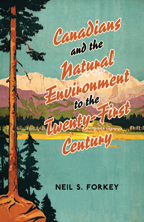Discover a wealth of interesting, entertaining and informative stories in each issue, delivered to you six times per year.
Nature's Past: Part 3 - The Environmental Movement
Coming up, Parts 4–6: Fisheries, Food Production, Tar Sands. See also: Part 1 Global Warming and Part 2 Aboriginal Health and Environments.
The environmental movement is one of the most popular topics in Canadian environmental history. At present, the environmental movement in Canada is at a bit of a crossroads. Having finally moved beyond simply outlining worst practices and their consequences, the last decade has witnessed proactive solutions and workable alternatives to every kind of environmental problem. Yet, this comes at the same time as economic turmoil and ideological opposition from government. Recently, David Suzuki has even gone so far as to argue that "Environmentalism has failed." Given this crossroads, environmental historians offer the context needed to understand the state of the environmental movement in this country today.
On this first part of our look at the history of the environmental movement in Canada we speak with Canadian environmental historian, Neil Forkey about his new book Canadians and the Natural Environment to the Twenty-First Century.
From the earliest efforts to establish national and provincial parks at the end of the nineteenth century to the more politically-conscious groups of the post-WWII era, historians of the Canadian environmental movement have demonstrated how changing ideas of nature informed non-utilitarian approaches to dealing with the non-human world. The inspiration for many of these ideas came from critiques of modernity and capitalism, which saw nature as either a set of commodities or an externality within the wider framework of progress and civilization. In response to this trend, concerned individuals and groups mobilized environmental sciences, such as conservation and ecology, to justify alternative relationships between humans and the natural world. This reaction to modern society and economy was shared with the United States, but also developed its own distinctive Canadian character, as well as specific regional approaches to environmental issues across Canada.
As in the United States, the first efforts to protect the environment in Canada arose out of anxieties about the loss of wilderness and the importance of preserving an essential national character at the end of the nineteenth century. Over half a century later, the postwar environmental movement in Canada evolved alongside that of the U.S. following the publication of Rachael Carson’s Silent Spring. In New Brunswick, activists fought to stop the spraying of DDT, while in Ontario a group known as Pollution Probe used the media to raise awareness of environmental issues, and in British Columbia the provincial government was obliged to enact protective legislation in order to placate opposition from environmentalists. In each case, changing ideas about nature combined with particular Canadian political and cultural contexts to transform the way most Canadians thought about and treated the environment.
 More Online Extras
More Online Extras
- Review this podcast on Sean's iTunes page
- Fill out a short listener survey
- Listen to previous podcasts on Nature's Past on NiCHE.
Suggested Readings
- Duke, David Freeland. Canadian Environmental History. Toronto: Canadian Scholar's Press, 2006.
- Gaffield, Chad and Pam Gaffield. Ed. Consuming Canada: Readings in Environmental History. Mississauga: Copp Clark, 1995.
- MacDowell, Laurel Sefton. An Environmental History of Canada. Vancouver: UBC Press, 2012.
- MacEachern, Alan and William J. Turkel. Ed. Method and Meaning in Canadian Environmental History. Toronto: Nelson, 2009.
- Wynn, Graeme. Canada and Arctic North America: An Environmental History. Santa Barbara: ABC-CLIO, 2007.
 © Nature's Past: A Podcast of the Network in Canadian History & Environment by Sean Kheraj is licensed under a Creative Commons Attribution-Noncommercial 2.5 Canada License. Based on a work at niche-canada.org.
© Nature's Past: A Podcast of the Network in Canadian History & Environment by Sean Kheraj is licensed under a Creative Commons Attribution-Noncommercial 2.5 Canada License. Based on a work at niche-canada.org.
Themes associated with this article
Advertisement




